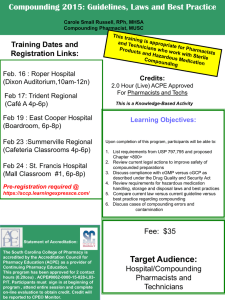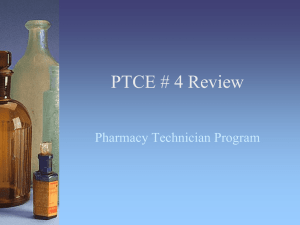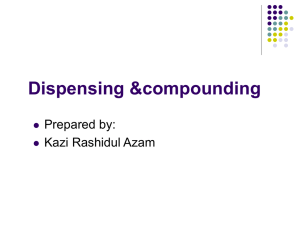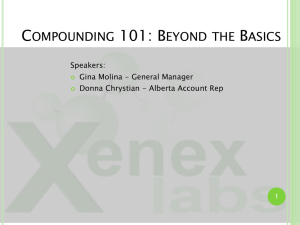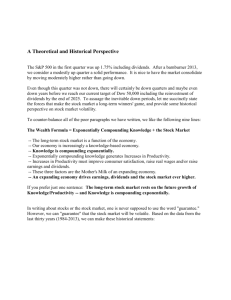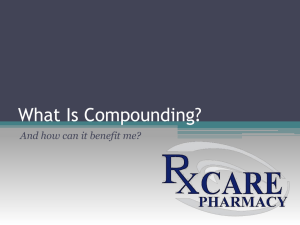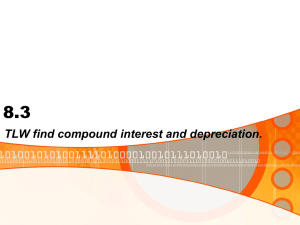File - Health Careers
advertisement
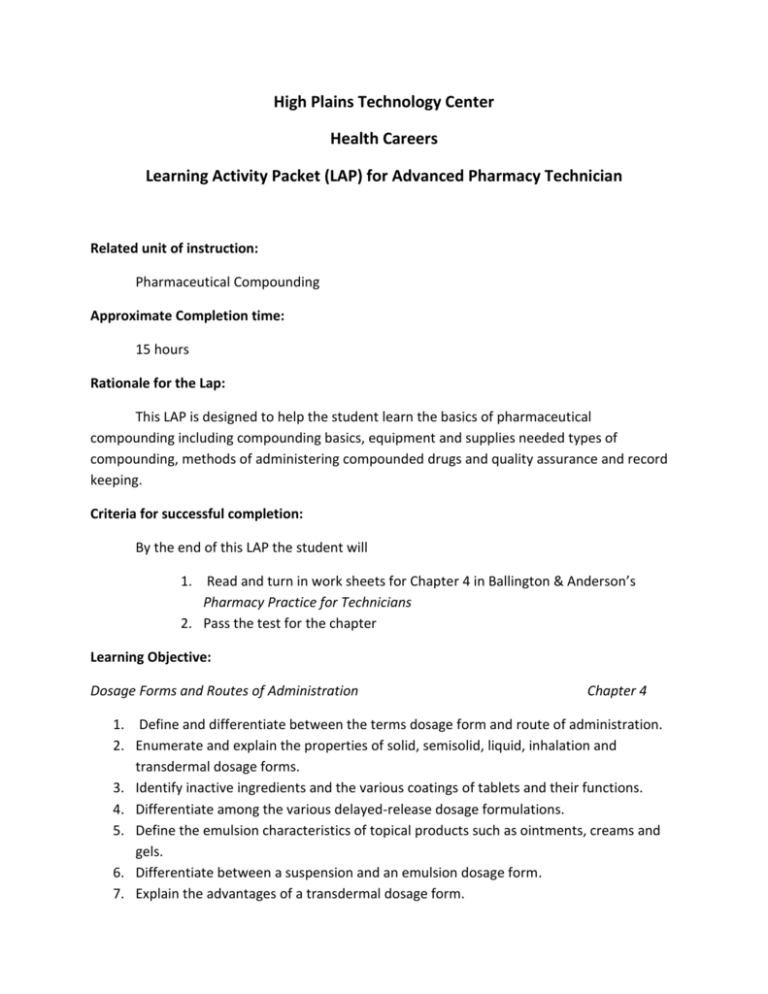
High Plains Technology Center Health Careers Learning Activity Packet (LAP) for Advanced Pharmacy Technician Related unit of instruction: Pharmaceutical Compounding Approximate Completion time: 15 hours Rationale for the Lap: This LAP is designed to help the student learn the basics of pharmaceutical compounding including compounding basics, equipment and supplies needed types of compounding, methods of administering compounded drugs and quality assurance and record keeping. Criteria for successful completion: By the end of this LAP the student will 1. Read and turn in work sheets for Chapter 4 in Ballington & Anderson’s Pharmacy Practice for Technicians 2. Pass the test for the chapter Learning Objective: Dosage Forms and Routes of Administration Chapter 4 1. Define and differentiate between the terms dosage form and route of administration. 2. Enumerate and explain the properties of solid, semisolid, liquid, inhalation and transdermal dosage forms. 3. Identify inactive ingredients and the various coatings of tablets and their functions. 4. Differentiate among the various delayed-release dosage formulations. 5. Define the emulsion characteristics of topical products such as ointments, creams and gels. 6. Differentiate between a suspension and an emulsion dosage form. 7. Explain the advantages of a transdermal dosage form. 8. List the major routes of administration and the advantages and disadvantages associated with each route of administration. 9. Discuss correct techniques for administration of eye drops, metered-dose inhalers, vaginal medications and injections. High Plains Technology Center Health Careers Learning Activity Packet (LAP) for Advanced Pharmacy Technician Related unit of instruction: Pharmaceutical Compounding Approximate Completion time: 15 hours Rationale for the Lap: This LAP is designed to help the student learn the basics of pharmaceutical compounding including compounding basics, equipment and supplies needed types of compounding, methods of administering compounded drugs and quality assurance and record keeping. Criteria for successful completion: By the end of this LAP the student will 1. Read and turn in work sheets for Chapter 8 in Ballington & Anderson’s Pharmacy Practice for Technicians 2. Pass the test for the chapter Learning Objective: Nonsterile Pharmaceutical Compounding Chapter 8 1. Define the term compounding, describe common situations in which compounding is required and identify examples of nonsterile compounding. 2. Review and follow good compounding practices in the pharmacy. 3. Distinguish terminology, such as manufactured product vs. compounded preparation. 4. Identify quality standards for nonsterile compounding contained in USP Chaper 795, including product selection and beyond-use or expiration dating. 5. Distinguish the components and purpose of a master control record from a compounding log. 6. Understand and calculate common mathematical problems that occur in a compounding pharmacy. 7. Identify and describe the equipment used for the weighing, measuring and compounding of pharmaceuticals. 8. Explain the proper techniques for weighing pharmaceutical ingredients, measuring liquid volumes and compounding nonsterile preparations. 9. Define the term percentage of error and understand how the concept relates to accuracy in the compounding pharmacy. 10. Explain the common methods used for comminution and blending of pharmaceutical ingredients. 11. Discuss the techniques by which solutions, suspensions, ointments, creams, powders, suppositories, and capsules are prepared. 12. Identify the steps that are necessary in the compounding process. 13. Identify references with a specialty focus on compounding. High Plains Technology Center Health Careers Learning Activity Packet (LAP) for Advanced Pharmacy Technician Related unit of instruction: Pharmaceutical Compounding Approximate Completion time: 15 hours Rationale for the Lap: This LAP is designed to help the student learn the basics of pharmaceutical compounding including compounding basics, equipment and supplies needed types of compounding, methods of administering compounded drugs and quality assurance and record keeping. Criteria for successful completion: By the end of this LAP the student will 1. Complete Labs 20 – 25 in Sparks and McCartney’s Pharmacy Labs for Technicians Learning Objective: Reconstituting Powders Lab 20 1. Demonstrate skill in measuring diluent and reconstituting powder medications for oral use. 2. Demonstrate competence in calculations related to reconstituting powder medications for oral use. 3. Discuss the rationale for and procedures related to reconstituting powder medication for oral use. 4. Practice common pharmacy calculations related to the preparation of oral liquid medications. 5. Become familiar with the compounding log as a means of recording the measurements, ingredients and procedures used in compounding nonsterile products. Filling Capsules Lab 21 1. Demonstrate proficiency in the process of compounding capsules from other dosage forms. 2. Demonstrate skill in the punch method used to fill empty capsules. 3. Demonstrate skill in use of laboratory equipment used in compounding. 4. Become familiar with the compounding log as a means of recording the measurements, ingredients and procedures used in compounding nonsterile products. Creating Suspensions from Tablets Lab 22 1. Demonstrate proficiency in the process of compounding an oral suspension from tablets. 2. Demonstrate competence in mathematical calculations related to the preparation of an oral suspension from tablets. 3. Discuss the procedure and rationale for compounding oral suspensions from tablets. 4. Become familiar with the compounding log as a means of recording the measurements, ingredients, and procedures used in compounding nonsterile products. Creating Suspensions from Capsules Lab 23 1. Demonstrate proficiency in the process of compounding an oral suspension from capsules. 2. Demonstrate competence in calculations related to the preparation of an oral suspension from capsules. 3. Discuss the procedure and rationale for compounding oral suspensions from capsules. 4. Become familiar with the compounding log as a means of recording the measurements, ingredients and procedures used in compounding nonsterile products. Preparing Creams, Ointments, Gels and Pastes Lab 24 1. Demonstrate proficiency in the process of nonsterile compounding, specifically in the preparation of topical gel. 2. Discuss the procedure and rationale for compounding nonsterile creams, ointments, gels and pastes. 3. Become familiar with the compounding log as a means of recording the measurements, ingredients, and procedures used in compounding nonsterile products. Making Lozenges Lab 25 1. Demonstrate proficiency in the preparation of compounded, custom-made lozenges. 2. Demonstrate skill in the use of laboratory equipment required for compounding. 3. Become familiar with the compounding log as a means of recording the measurements, ingredients, and procedures used in compounding nonsterile products.
